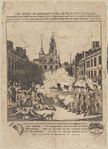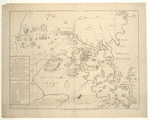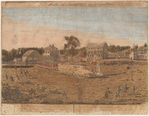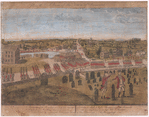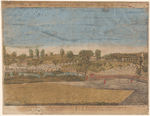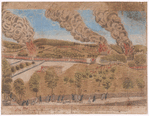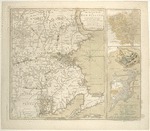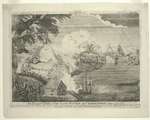|
Section I Selections from the C.W. McAlpin Collection
Section I Dawn of the American Revolution, 1768-1776Section I
At the end of the French and Indian War in 1763, Great Britain gained control of all of North America east of the Mississippi River, but was also left with a massive war debt and the difficulty of maintaining sovereignty in the colonies. As a means of raising revenue and asserting authority, Parliament passed a number of acts: the Sugar Act (1764), the Quartering Act (1765), the Stamp Act (1765), and the Townshend Acts (1767). Colonists objected to “taxation without representation” and demonstrated their disapproval by boycotting British goods and flagrantly flouting the new regulations. In 1768, British warships arrived in Boston Harbor to quell the growing rebellion and close the port. This depiction of the troops disembarking at Long Wharf is one of three views of the subject by Paul Revere. Revere, a successful silversmith and engraver, was a member of the Sons of Liberty and was actively involved in colonial resistance to the Parliamentary acts.
The tension between Bostonians and the British standing army exploded on March 5, 1770. On that day, a group of locals were taunting and harassing soldiers stationed outside the Custom House. The British opened fire, leaving five civilians dead. News of this tragedy, dubbed the “Boston Massacre,” was widely reported and fueled the patriotic cause. In the following weeks, the artist Henry Pelham created this view of the event. When Paul Revere apparently saw this image, he immediately pirated the design and issued his own engraving. Revere’s Bloody Massacre was widely circulated and remains one of the best-known images of the Revolution. Pelham’s engraving, which was issued one week after Revere’s copy, is exceedingly scarce; only one other impression is known, a hand-colored version at the American Antiquarian Society in Massachusetts.
By the spring of 1775, British troops had been stationed in Boston for almost seven years. Their reports back home detailed the escalating and increasingly well-organized resistance by the colonists to British rule. As the rebellion became more pronounced, General Thomas Gage, the royal governor of Massachusetts, received orders from London to seize the colonists' stockpile of weapons and supplies in Concord, a town about 20 miles northwest of Boston. Led by General Gage, a troop of 700 British soldiers began their march on April 18, 1775. This map traces their advance toward Concord and their bloody encounters with militiamen along the way. By the time it was published in London in late July, engraver Charles Hall was able also to include depictions of the more recent events at Bunker Hill.
Amos Doolittle’s Battles of Lexington and Concord Amos Doolittle was one of America’s first printmakers. Born in Connecticut, he trained as a jeweler and silversmith and engraved a number of bookplates, maps, and portraits. He is most famous for these four views of the Battles of Lexington and Concord, which are the only contemporary visual accounts of the events by an American artist. A few days after the battles, Doolittle, one of the founding members of a New Haven militia company, volunteered to go to Boston and spent several weeks serving in Cambridge. During that time, he probably traveled to Lexington and Concord to record these views.
While the British marched toward Concord, two colonists, Paul Revere and William Dawes, set out from Boston to sound the alarm that the British were coming. Thanks to this advance warning, around seventy Massachusetts militiamen gathered the next morning on Lexington Green to meet the advancing troops. A shot was fired, fighting broke out, and when the smoke cleared eight Americans lay dead and several Americans and British were wounded. Although it still remains unclear who fired first, Doolittle identifies the British troops led by Major Pitcairn as “The Party, who first fired on the Provincials at Lexington.”
After their success on the green at Lexington, the British continued to their destination in Concord. As they marched into the center of town, Major Pitcairn and Colonel Smith kept watch on the militiamen from a cemetery on a hill. Although the British followed orders to search for and seize all weapons and food, the colonists had already removed or hid most of their supplies.
The British set fire to the small cache of supplies they seized in Concord. Fearful that they were burning the town, militiamen advanced on Concord and clashed with the redcoats at the North Bridge. After numerous soldiers were wounded, the British decided to retreat and began to march back to Boston.
During the 20-mile retreat to Boston, the British troops were continuously fired upon by farmers and Minutemen. Minutemen, first organized in 1774, were militiamen trained to assemble at a moment’s notice. The Battles of Lexington and Concord tested their ability to organize quickly, and they succeeded admirably. These battles also emphatically confirmed the hostilities between the Americans and the British and roused the fighting spirit of the patriots. In the following weeks, thousands of New Englanders volunteered to join the fight.
After the Battles of Lexington and Concord, American militiamen forced the British to retreat to Boston and set up military blockades around the city. This siege of Boston lasted nearly a year, from April 19, 1775, to March 17, 1776. Men from Massachusetts, Rhode Island, New Hampshire, and Connecticut answered the call of duty. This map by an unknown “American volunteer” traces their routes toward Boston. It was issued by the prominent London map publishers Robert Sayer and John Bennett and includes two insets that showcase the city in greater detail: a survey of the harbor and a plan of the Battle of Bunker Hill.
Two months after the siege of Boston began, at least 15,000 American troops surrounded the British-occupied city. Eager to gain a strategic position on the Charlestown peninsula, the patriots fortified Breed’s Hill, just below Bunker Hill (for which the ensuing battle is typically named). On June 17, 1775, Major General William Howe launched a full-frontal assault on Breed’s Hill. Wave after wave of British soldiers stormed up the hill under a barrage of musket fire. Although their attacks were ultimately successful, the British suffered more than 1,000 casualties. Three months later, Bernard Romans issued this view of the first major battle of the American Revolution. Romans, a Dutch-born surveyor and botanist, immigrated to America in 1757 and worked in Florida publishing maps and natural histories. After moving north, he became involved in the colonists’ fight for independence and participated in the Battle of Bunker Hill.
An Original Sketch of the Burning of Charlestown & Battle of Bunker Hill. Taken by an English Officer from Beacon Hill Boston A British soldier, possibly Thomas Davies, depicted this aerial view of the Battle of Bunker Hill. According to contemporary accounts, Boston locals flocked to rooftops, church steeples, and other elevated vantage points to watch the battle unfold. The day was bright and sunny, and spectators had a clear view of the events from places as distant as Beacon Hill, from which this view is taken. |


